Pasolini presenta/a is the title of the show inaugurated on August 11 with which the city of Tolmezzo (UD) and the whole Carnia, pay tribute to one of the most influential and controversial intellectuals of XX century: Pier Paolo Pasolini. Included in a wider project with the projection of a documentary and a concert in his memory, the exhibition proposes to investigate the figure of Pasolini through the unique documents coming from the extraordinary collection of Egidio Marzona, one of the most important collectors in Europe.
Juliet has had the pleasure to make some question to the curator of the show, Michela Lupieri.
For the first time the city of Tolmezzo has entertained a review dedicated to Pier Paolo Pasolini, one of the most influential and controversial intellectuals of XX century, and it want to investigate his figure through a show composed by finds and original documents, the projection of a documentary and a concert. Which has been the idea at the base of the project and how it has been developed?
The project has started from the Egidio Marzona’s collection on Pasolini, an Italian collector and founder of the Art Park in Villa di Verzegnis (Ud) and owner of one of the most important files on the Avant-garde (and not only) of the XX century. The collection on Pasolini, indeed least if considered the vastness of his file, has never been exposed to the public and Marzona asked Palazzo Frisacco in Tolmezzo for the exhibition, chief town of the Carnia, his origin land. The town administration has positively welcomed this idea entrusting me some trusteeship of the show and the artistic direction of the whole project. Before to such an important charge I have used some scientific collaboration of Karol Jóźwiak that I have invited to co-curating of the project and the catalog of accompaniment to the show and Angela Felice (manager of the Center Studi Pasolini of Casarsa) that I have invited to curate the section of the show devoted to Pasolini “friulano”. In front of the heterogeneity and wealth of the collection we have imagined a composite review able to communicate so much of Pasolini’s production and the actuality of his thought. From here the idea of the title of the review Pasolini was born it foresees structured in three autonomous but connected moments: the show, conceived as principal fulcrum, the projection of a film and the concert. For the projection we have individualized the documentary shooted by Pasolini in 1970 Appunti per un’Orestiade africana.
The choice has reverted on this a little known film to the more – it doesn’t deal with a concluded film but of a series of notes of images in movement for a film to make – for his to constitute him as I spin conductor among the different historical epochs. How Pasolini in 1970 had wanted to readapt the tragedy of Eschilo to the social context of the new African democracy so, today, the projection of this documentary has allowed us to connect the past of the Pasolini’s thought to the most urgent problem list of the present to us contemporary. The review is finally concluded with the concert of Pasolini’s films with the prestigious musicians of the Berliner Philharmoniker – Salvatore Percacciolo, Clemens Weigel, Luis Felipe Coelho – that have reinterpretated the music that sonorous column of the films. Among so many, for instance, the famous passage Che cosa sono le nuvole of Modugno are whose title takes back the fourth episode of the film Capriccio all’italiana turned by Pasolini in the 1967.
With the show “Pasolini presenta/e. Pier Paolo Pasolini in the Egidio Marzona’s collection (visible to Palazzo Frisacco up to November 5, 2017) are exposed for the first time the documents only and original legacies to the figure of Pasolini coming from the vast and precious collection of Egidio Marzona. Can you speak to us of this “encyclopedic exhibition” in to become and as the pieces on show have been selected…
The show has a very specific cut because the visitor is conducted inside the collection of Marzona about pasolini from the very specific theme and still in continuous expansion. The principal corpus is composed by the original versions of the manifestos, of the poster and of cinema fotobustes, of Italian and international production, of the films for which Pasolini has been both director and scriptwriter. To this they are added a heterogeneous whole documents as you hover, seen again, clippings of newspaper, sketches, rare books of artist, photos and frames. It is impossible to contain with precise confinements the vastness of his production both the whole file Marzona he has brought me to imagine Palazzo Frisacco as a sort of facing encyclopedic building to contain the collection in its totality. As in the Pasolini’s production to the poetries written in Italian and dialect friulano are added the novels, the critical wise man, the screen-plays, the films, the sketches, the paintings, so the file Marzona is in his trans-disciplinary essence, centrifugal and ubiquo. The same Marzona, in fact, to describe his own approach to collect resorts to the metaphor of the mosaic since for him the presence of every single unity is necessary and fundamental to communicate the complexity of the collection. Therefore in show, every single exposed unity enters relationship with activating a dialogue system of you postpone and connections that it communicates the encyclopedic vision that is to the base of it. The collection is exposed according to a chronological criterion that beginning from 1961 (year in which for the first time Pasolini takes in hand the video-camera to filming “Accattone”) the visitor accompanies up to the 2017. This because every room, conceived as a chapter of the encyclopedic building, introduces a precise thematic nucleus: beginning from the “Paesaggi Romani” crossing “Il Vangelo”, Le allegorie della modernità, le Mitologie, le Sceneggiature, La trilogia della vita, La premonizione della morte, la Commemorazione until to reach L’archivio del presente where in a video Marzona tells the origin of his interest for Pasolini. “Pasolini presenta/e” it is a show of images and every room is deprives of explanatory texts because we have decided to let speak the file and the materials of which is composed.
The title of the show plays with the writing “P.P. Pasolini introduces”, wording that is found engraved in the cinema manifestos and the word “present.”.. can you tell us as the concept of presence both the thread conductor of the exposure?
The show, as also the catalog, opens with the image of the poster of the film “Ostia” and is closed with the same manifesto with brought the same image: that of a dead man on a beach, whose shape has just been taken to beatings. Not only “Ostia” is the 1970 film title, with the regal one of Sergio Citti and the screen-play of Pasolini, but it is the place in which Pasolini has been murdered. His body, in fact, has been found massacred on a beach of the beach of Ostia on 2 November of 1975 . If this place has been the end of the human run of Pasolini, the cinema manifesto has been for us curators so much the beginning how much the end of the exhibition. It almost seems, therefore, that in the writing of the film the author has given voice to a sort of premonition of the end of his life would be revealed. This image have a fundamental importance and it is around this same that we have structured the whole leit motiv of the show: a run that explores the theme of the presence, in narrow dialogue with that of the death of the author, under different aspects. From the presence of Pasolini’s thought in different fields of the to know – as they testify the exposed documents – and therefore the appeal to the languages of the cinema, of the writing or of the sketch, through his presence in the films not only as director but also as scriptwriter or actor to reach his presence in a place, the Friuli, because it is here that he has been buried in the cemetery of Casarsa. The most important aspect is the presence of Pasolini inside one of the most important files to the world and the file it is not that a space, a place, facing to crystallize the to flow some time as the memory of what preserve. Marzona writes that the file is not that the simplest way to fight the death. In the text Pasolini presence of the catalog Karol Jóźwiak writes: “Pasolini says that <<in our art we don’t do anything else other than to represent the reality: and this representation is not that an anticipation of the death. Every time that a poet writes ago a poetry or a director a film, you/he/she dies. That is he becomes fitter: and the assemblage is, note, the transformation of the present in past.>> To capture this ephemeral moment of transition between the present and the past, between the life and the death, it is the paradox of the absence of the presence. This concept seems to reside both in the files of Marzona and in the works of Pasolini. The show tries to make light on this aspect, through the presence of Pasolini in the Marzona’s file.”
Both Pier Paolo Pasolini and Egidio Marzona are indissolubly tied to this territory, to its history and above all to its language. The show therefore as an important moment of exploitation of this place…
The show introduces a double section devoted to Pasolini’s relationship with Friuli in which a series of external documents to the collection goes to converse with Marzona’s collection. On one side there is the section Una scatola sonora per Pasolini curated by Angela Felice where an accurate selection of sentences, single words or verses in Italian and friulano and a “sonorous landscape” submitted to actor Massimo Somaglino’s voice, conduct the visitor in the linguistic universe of Pasolini. In this room, where the images are replaced by the words, the principal themes are the language, the relationship between Pasolini and the different geographical contexts and particularly of Friuli and its Casarsa. In the second section, thanks to the collaboration with the Study Valley Designs in partnership with the city of Udine, the projects of the grave of Pasolini are introduced and conceived by the architect Gino Valle in the 1977. In the show they are exposed the sketch makes with pencil of the project and a series of photos of author that show the grave of Pasolini in relationship to the landscape of Casarsa.
Which considerations can you express about the result of the project and which is the impact on the public?
The good result of a so various and complex review has been possible both thanks to the help of a lot of people both thanks to the collaboration with public and private authorities that have believed in the project, allowing the feasibility of it. The Commune of Tolmezzo, Reset association and the Foundation Friuli have been fundamental: they have promoted the initiative but, above all, have given a precious contribution to the show with all of the innumerable partners and sponsor that have collaborated to the same project. Everything has made me understand that in front of projects that on the paper seem almost impossible, the best strategy is to open to the comparison and to resort to the collaboration with more realities of different nature. In this way the contribution of each of them becomes a fundamental wedge for the good result of the project. The feedback of the public has been very positive during the three days of the review and during the months of opening of the show.
Magali Cappellaro
Info:
Pasolini presenta/e. Pier Paolo Pasolini nella collezione Egidio Marzona
2017, August 11 – November 5
Palazzo Frisacco, Via Renato del Din 7, Tolmezzo (UD)
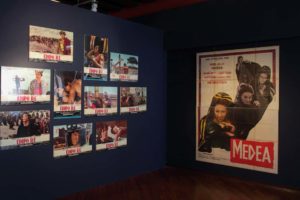 Capitolo 4. Mitologie. Pasolini film posters 1967-1969. Ph. courtesy A. Nazzi, Studio Foto Livio.
Capitolo 4. Mitologie. Pasolini film posters 1967-1969. Ph. courtesy A. Nazzi, Studio Foto Livio.
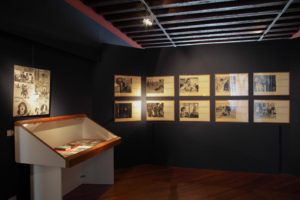 Capitolo 1. Paesaggi romani. Pasolini film posters 1961-1962. Ph. courtesy A. Nazzi, Studio Foto Livio.
Capitolo 1. Paesaggi romani. Pasolini film posters 1961-1962. Ph. courtesy A. Nazzi, Studio Foto Livio.
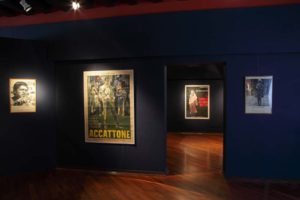 Capitolo 1. Paesaggi romani. Pasolini film posters 1961-1962. Ph. courtesy A. Nazzi, Studio Foto Livio
Capitolo 1. Paesaggi romani. Pasolini film posters 1961-1962. Ph. courtesy A. Nazzi, Studio Foto Livio
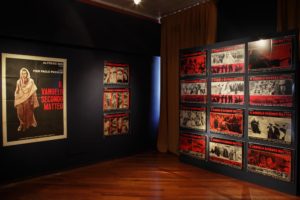 Capitolo 2. Il vangelo secondo Matteo. Pasolini film posters 1964. Ph. courtesy A. Nazzi, Studio Foto Livio
Capitolo 2. Il vangelo secondo Matteo. Pasolini film posters 1964. Ph. courtesy A. Nazzi, Studio Foto Livio
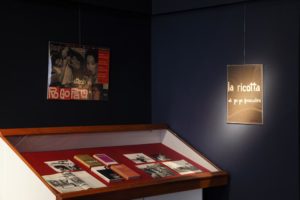 Capitolo 3. Allegorie della modernità. Pasolini film posters 1965-1968. Ph. courtesy A. Nazzi, Studio Foto Livio.
Capitolo 3. Allegorie della modernità. Pasolini film posters 1965-1968. Ph. courtesy A. Nazzi, Studio Foto Livio.
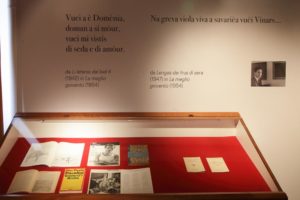 Capitolo 7. Una scatola sonora per Pasolini. La poesia e il Friuli. A cura di Angela Felice. Ph. courtesy A. Nazzi, Studio Foto Livio.
Capitolo 7. Una scatola sonora per Pasolini. La poesia e il Friuli. A cura di Angela Felice. Ph. courtesy A. Nazzi, Studio Foto Livio.
 Capitolo 8. La premonizione della morte. Salò 1975. Ph. courtesy A. Nazzi, Studio Foto Livio.
Capitolo 8. La premonizione della morte. Salò 1975. Ph. courtesy A. Nazzi, Studio Foto Livio.
 Capitolo 8. La premonizione della morte. Ostia 1970. Ph. courtesy A. Nazzi, Studio Foto Livio.
Capitolo 8. La premonizione della morte. Ostia 1970. Ph. courtesy A. Nazzi, Studio Foto Livio.
 Capitolo 7. Una scatola sonora per Pasolini. La poesia e il Friuli. A cura di Angela Felice. Ph. courtesy A. Nazzi, Studio Foto Livio.
Capitolo 7. Una scatola sonora per Pasolini. La poesia e il Friuli. A cura di Angela Felice. Ph. courtesy A. Nazzi, Studio Foto Livio.

is a contemporary art magazine since 1980





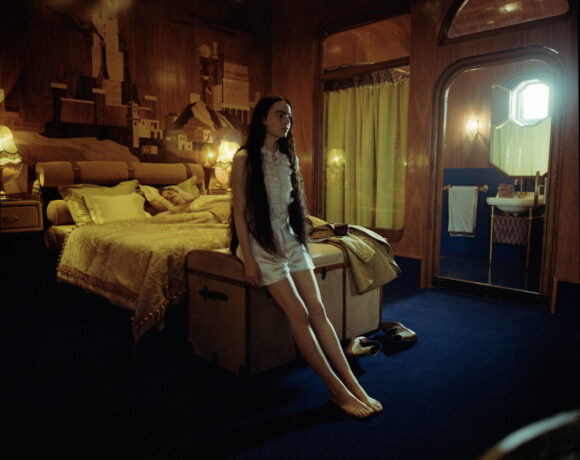

NO COMMENT